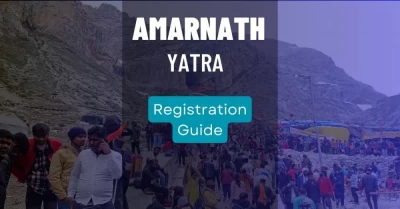Amarnath Yatra Fitness Guide

The Amarnath Cave, located at a height of 14,800 feet, offers a physically demanding pilgrimage that challenges trekkers with its rugged, high-altitude terrain. The Amarnath Yatra requires endurance and strength to navigate steep ascents, unpredictable weather, and thin air, which can make breathing more difficult. To successfully complete the Amarnath trek and ensure your safety, it is crucial to properly prepare your body for the physical strain ahead.
Get complete health guide for Amarnath Yatra
This fitness guide will help you build the necessary endurance, strength, and overall fitness to tackle the challenges of the Amarnath Yatra. By focusing on stamina, strength training, and acclimatization, you can ensure that you’re physically prepared for the demanding conditions of the pilgrimage. With the right preparation, you will be ready to face the trek’s physical and mental challenges, making your journey to the Holy Cave of Shri Amarnathji a rewarding and fulfilling experience.
Amarnath Yatra Trek Routes
- Pahalgam Route: This is a longer and more scenic route. The trek covers approximately 47 kilometers over 3-4 days, with steep ascents, high altitudes, and uneven terrain. Key points like Pissu Top, Sheshnag Lake, and Panchtarni require good physical endurance.
- Baltal Route: This route is shorter then pahalgam route approximately 14 km but steeper, narrow and more strenuous. It takes around 1-2 days to complete, with a challenging climb to the Amarnath Cave.
Compulsory Health Certificate for Amarnath Yatra
One of the requirements for participation in the Amarnath Yatra is obtaining a fitness certificate known as Compulsory Health Certificate. All pilgrims intending to undertake the Amarnath Yatra are required to provide a fitness certificate. This is especially important as the yatra takes place in a high-altitude area and requires physical endurance. The certificate ensures that the person is physically fit to handle the demands of the journey.
How to Get Amarnath Yatra Fitness Certificate
The fitness certificate must be issued by a registered medical practitioner. This doctor must be a government-registered medical professional or recognized by the government. The certificate should be based on a thorough medical check-up.
There is List of Doctors / Institutions as per State / UT wise which are authorised to issue Compulsory Health Certificate (for Shri Amarnathji Yatra) as received from respective State / UT Governments.
List of Doctors / Institutions for Shri Amarnathji Yatra 2024Note : Although major List of Doctors / Institutions is same for Shri Amarnath Yatra every year, the list for 2025 will be updated soon.
Format of Compulsory Health Certificate for Amarnath Yatra
There is a prescribed format for Compulsory Health Certificate for Amarnath Yatra each year. All pilgrims must adhere to the format for any fitness certificate submission as prescribed by the Shri Amarnath Shrine Board (SASB) to ensure their eligibility for the yatra.
Download Format of Compulsory Health Certificate for Shri Amarnathji Yatra 2024Note : The fitness certificate is usually valid for a specific period leading up to the yatra, often around a few weeks (typically 30 days) before the date of the trek. Although CHC format is same for Shri Amarnath Yatra every year, the format for 2025 will be updated soon.
Fitness Guidelines for Amarnath Yatra
- Stamina Building: it is advisable start a 4-5 km walk, either in the morning or evening, at least a month before the Yatra. Include stair climbing to strengthen leg muscles and improve cardiovascular endurance, simulating uphill terrain. Cycling is another effective way to build leg strength and enhance overall stamina. These exercises will prepare you for the physical demands of the trek.
- Altitude Training: The Amarnath Cave sits at a high altitude, where lower oxygen levels can make breathing more challenging. To prepare, train your body to adapt to reduced oxygen by incorporating deep breathing exercises like pranayama (yogic breathing) to enhance lung capacity and improve oxygen efficiency. This will help your body function better in high-altitude conditions.
- Strengthening Your Mental Toughness: The Amarnath Yatra is both physically and mentally demanding. Long treks in challenging conditions can test your mental resilience. To prepare, practice meditation and mindfulness to maintain calm and focus. Visualize successfully completing each stage of the journey, boosting your mental strength and making the trek feel more achievable.
- Strengthening Lower Body Muscles: The trek to Amarnath involves steep ascents and descents, making it essential to strengthen your legs and core. Squats effectively target the thighs, glutes, and calves, which are vital for both uphill and downhill trekking. Building strength in these areas will improve your stability and endurance throughout the journey.
- Consult a Doctor: If you have any underlying health conditions, it’s important to consult a doctor before starting your fitness regimen for the yatra. Additionally, check with a healthcare professional about necessary vaccinations and precautions for altitude sickness to ensure you're fully prepared for the trek.
- Health and Nutrition: A balanced diet is crucial for preparing your body for the demanding trek. Focus on foods that support endurance and aid recovery. Staying hydrated is essential for maintaining energy levels and preventing altitude sickness. Avoid trekking on an empty stomach, as it can lead to serious health issues. Make sure to eat small, regular meals during the trek to maintain energy and prevent exhaustion.
Health Advisory for Helicopter Pilgrims – Shri Amarnathji Yatra
The Holy Cave of Shri Amarnathji, situated at 13,500 feet in the South Kashmir Himalayas, exposes visitors to extreme cold, low oxygen levels, and high UV radiation. Since the Amarnath helicopter journey allows only a short stay at high altitude, your body may not have enough time to acclimatize.
Key Health Guidelines:
- Avoid exertion – Walk slowly, breathe deeply, and allow your body to adjust.
- Use a Horse or Palki – Trekking is not recommended due to low oxygen levels.
Common High-Altitude Sicknesses & Symptoms:
Acute Mountain Sickness (AMS) – Occurs above 2,500m
Symptoms: Headache, nausea, dizziness, breathing issues, fatigue, loss of appetite.High Altitude Cerebral Edema (HACE) – A severe form of AMS
Symptoms: Severe headache, vision problems, confusion, weakness, paralysis.
This condition can lead to coma or death if untreated.High Altitude Pulmonary Edema (HAPE) – Fluid accumulation in the lungs
Symptoms: Shortness of breath (even at rest), dry cough, chest tightness, extreme fatigue.
This condition can be fatal within hours if not addressed.
Younger individuals are more prone to high-altitude sickness due to overexertion. Stay cautious, hydrated, and seek medical help if symptoms appear. Stay Safe & Have a Peaceful Pilgrimage.
Tips for Amarnath Yatra Trek
Beginning on th Amarnath Yatra and confused what to do below are some tips for the pilgrims who are beginning on the amarnath journey for an smooth and relaxing journey.
- It’s important to pack wisely for the Amarnath Yatra, and one of the best ways to prepare is by training with the gear you intend to carry, such as a backpack, walking stick, and trekking shoes. Make sure all your equipment is comfortable and well-fitted to prevent discomfort during the trek.
- Getting enough sleep before your journey is essential, as proper rest helps with muscle recovery and enhances your overall performance during the trek. Ensuring you are well-rested will prepare you physically and mentally for the challenges ahead.
- During the Amarnath Yatra trek, be prepared for sudden weather changes, including rain, with cold mornings, warmer afternoons, and the need for waterproof gear.
- The trek can be both physically and mentally exhausting, so it’s important to stay patient and determined throughout. Enjoy the natural beauty along the way, avoid stressing about the destination, and embrace the journey itself.
- Amarnath is a religious pilgrimage site, so it's important to respect the customs, practices, and rituals followed by the devotees. Dressing modestly and acting with reverence around the shrine and its surroundings will help you honor the sacredness of the place.
- It’s essential to have a medical check-up before undertaking the yatra, particularly if you have pre-existing conditions like heart issues or asthma, to ensure you're fit for the journey.
- Staying hydrated is essential during the Amarnath Yatra, as the dry environment and high altitudes can cause dehydration. Make sure to drink plenty of water throughout the trek to maintain energy levels. Carry a water bottle and refill it at available sources along the way.
Do’s & Don’ts during Amarnath Yatra
The Holy Cave of Shri Amarnathji, situated at 13,500 feet in the South Kashmir Himalayas, exposes visitors to extreme cold, low oxygen levels, and high UV radiation. Here are things to consider, things which you can do and avoid to make your tour safe and memorable one.
Do's
- Increase your fitness. Start a 4-5 km morning/evening walk at least a month prior to the Yatra. This is to improved the oxygen efficiency of your body.
- Take Palkis/Horses instead of trekking to avoid high altitude sickness.
- Take short breaks to catch your breath when tired.
- Notice any symptoms such as extreme tiredness, headache, nausea, loss of appetite or vomiting.
- Saree is NOT a suitable dress for the Yatra. Salwar Kameez, pant-shirt or a track suit will be better. Ladies who are more than 6 week pregnant shall not be allowed to undertake the pilgrimage.
- Keep spare clothes and eatables in a suitable water proof bag.
- Carry some cold cream/Vaseline/sunscreen to protect your hands /face against sunburn etc.
- Keep in your pocket your yatra Permit or any other identity card, incase of an emergency.
Don’ts
- Don’t stop at places which are marked by warning notices.
- Don’t exert yourself too much and get out of breath.
- Don’t ignore any symptoms such as extreme tiredness, headache, nausea, loss of appetite or vomiting.
- Don’t use slippers because there are steep rises and falls on the route to the Holy Cave. Only wear trekking shoes with laces.
- Don’t attempt any short cuts on the route as doing so would be dangerous.
- Don’t trek alone. Always stay together as a group. Mobile networks do not work at Panjtarni. Incase you are lost or lose any of your group members, there is a Public Announcement (PA) system at Panjtarni.
Conclusion
The Amarnath Trek is a challenging but rewarding journey that requires both physical and mental preparation. Pilgrims planning to undertake the Yatra should focus on building their fitness to avoid exhaustion during the trek. Proper training, mental resilience, and a thoughtful approach to health and nutrition will ensure a successful and fulfilling pilgrimage experience.




